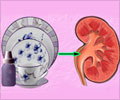The functions of the kidney are many and include filtering blood, removing waste products from the body, balancing the body's fluids

Scientists have now begun to understand kidney damage on a cellular level and how the activity of certain molecules in damaged kidneys contributes to salt and water retention in nephrotic syndrome. Several new insights in this area of research will be presented at the7th International Symposium on Aldosterone and the ENaC/Degenerin Family of Ion Channels, being held September 18-22 in Pacific Grove, Calif. The meeting is sponsored by the American Physiological Society.
Faulty FiltrationThe kidneys are marvels of filtration, processing roughly 150 to 200 quarts of blood each day through tiny structures called nephrons. There are about 1 million nephrons per kidney, and each nephron consists of a filtering unit of blood vessels called a glomerulus, which is attached to a tubule. Filtered blood enters the tubule, where various substances are either added to or removed from the filtrate as necessary, and most of the filtered sodium and water is removed. The filtrate that exits the tubule is excreted as urine.
In nephrotic syndrome, a damaged filtration barrier allows substances that are not normally filtered to appear in the filtrate. One of these substances is the protein plasminogen, which is converted in kidney tubules to the protease plasmin. In their research, Thomas R. Kleyman, Professor of Medicine and of Cell biology and Physiology at the University of Pittsburgh School of Medicine and the Symposium's co-organizer, and Ole Skøtt, Professor of Physiology and Pharmacology and Dean at the University of Southern Denmark in Odense, independently found that plasmin plays a role in activating the epithelial sodium channel (ENaC) on cells in the nephron. ENaC is a protein embedded in cell membranes that facilitates the absorption of filtered sodium from tubules. When ENaC is becomes overactive, excessive absorption of filtered sodium may lead to sodium and water retention.
According to Dr. Kleyman, these findings provide an explanation of how damage to the glomeruli in the kidney's nephrons leads to edema and high blood pressure. Dr. Kleyman explains: "When plasminogen is cleaved, it can act on several targets. One of those targets is ENaC. Another is the protein prostasin, which, once cleaved, will activate ENaC, as well."
Dr. Kleyman noted the implications these findings have for treating edema and high blood pressure in patients suffering from nephrotic syndrome. "This is important because if plasmin activates ENaC, it suggests that targeting ENaC in the kidneys with ENaC inhibitors may be a treatment option."
Advertisement
Source-Eurekalert














